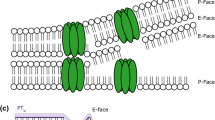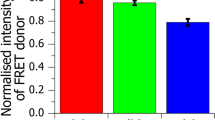Summary
Ultrarapid cyrofixation procedures revealed the existence of ordered arrays of intramembrane particles on E fracture faces and corresponding ordered imprints on P faces in freeze-fractured plasma membrane of the green algaeChlamydobotrys stellata (Korschikoff). The structure of these arrays is very sensitive to cryofixation conditions and particularly to glutaraldehyde prefixation which leads to the formation of amorphous two-dimensional aggregates. The size of the individual ordered arrays and the ratio of ordered to total surface of the membrane increase with growth temperature from 15°C to 30°C with a corresponding decrease in cell generation time. Above 30°C the size of the individual ordered arrays decreases. At high, but sublethal temperature (above 37°C) the ordered arrays become smaller. In addition to the predominant two-dimensional oblique organization (a=12.0nm, b=12.6nm, γ=80°), square and tetragonal arrangements are also present. The cell wall is composed of many layers, one of which displays a “zipper-like structure” composed of periodic ridges 25 nm distant, sandwiched between two more or less fibrillar layers. The appearance and changes of the organization of ordered arrays are discussed in relation to their eventual physiological role during the life cycle of the cells and in particular to the formation of the cell wall and the median periodic leaflet.
Similar content being viewed by others
References
Arancia, G., Rosati-Valente, F., Trovalusci-Crateri, P., 1980: Effects of glutaraldehyde and glycerol on freeze-fracturedEscherichia coli J. Microscopy118, Pt. 2, 161–176.
Bachmann, L., Schmitt, W. W., Plattner, H., 1972: Improved cryofixation: demonstrated on freeze etched solutions, cell fractions and unicellular organisms, p. 244 (Proc. Fifth European Congress on Electron Microscopy). London and Bristol: The Institute of Physics.
Bray, D. F., Nakamura, K., Costerton, J. W., Wagenaar, E. B., 1974: Ultrastructure ofChlamydomonas eugametos as revealed by freeze-etching: cell wall, plasmalemma and chloroplast membrane. J. Ultrastruct. Res.47, 125–141.
Brown, R. M., Montezinos, D., 1976: Cellulose microfibrils visualization of biosynthetic and orienting complexes in association with the plasma membrane. Proc. Natl. Acad. Sci. U.S.A.73, 143–147.
Catt, J. W., Hills, G. J., Roberts, K., 1976: A structural glycoprotein containing hydroxyproline isolated from cell wall ofChlamydomonas reinhardii. Planta131, 165–171.
— — —, 1978: Cell wall glycoproteins fromChlamydomonas reinhardii and their self-assembly. Planta138, 91–98.
Dempsey, G. P., Bullivant, S., Watkins, W. B., 1973: Endothelial cell membranes. Polarity of particles as seen by freeze-fracturing. Science179, 190–192.
Ettl, H., 1970: Die GattungChloromonas gobi emend. Wille. Beih. Nova Hedwigia, Heft 34.
Giddings, T. H., Brower, D. L., Staehelin, L. A., 1980: Visualization of particle complexes in the plasma membrane ofMicrasterias denticulata, associated with the formation of cellulose fibrils in primary and secondary cell walls. J. Cell Biol.84, 327–339.
Gilula, N. B., Satir, P., 1971: Septate and gap junctions in molluscan gill epithelium. J. Cell Biol.51, 869–872.
——, 1972: The ciliary necklace-A ciliary membrane specialization. J. Cell Biol.53, 494–509.
Gross, H., Kuebler, E., Bas, E., Moor, H., 1978: Decoration of specific binding sites on freeze-fractured membranes. J. Cell Biol.79, 646–657.
Gulik-Krzywicki T.,Costello M. J., 1977: Evaluation of freezing methods by low temperature X-ray diffraction (Bailey, G. W., ed.), pp. 330–333. 35th Ann. Proc. Electr. Microscopy. Boston Mass.
Henderson, R., Unwin, P. N. T., 1975: Three-dimensional model of purple membrane obtained by electron microscopy. Nature257, 28–31.
Herth, W., 1983: Arrays of plasma membrane “rosettes” involved in cellulose microfibril formation ofSpirogyra. Planta159, 347–356.
Hills, G. J., Gurney-Smith, M., Roberts, K., 1973: Structure, composition and morphogenesis of the cell wall ofChlamydomonas reinhardi. II. Electron microscopy and optical diffraction analysis. J. Ultrastruct. Res.43, 179–192.
Hughes, J., McCully, M. E., 1975: The use of an optical brightener in the study of plant structure. Stain Technology50, 319–329.
Kiermayer, O., Staehelin, L. A., 1972: Feinstruktur von Zellwand und Plasmamembran beiMicrasterias denticulata (Breb.) nach Gefrierätzung. Protoplasma74, 227–237.
—,Sleytr, U. B., 1979: Hexagonally ordered “rosettes” of particles in the plasma membrane ofMicrasterias denticulata and their significance for microfibril formation and orientation. Protoplasma101, 133–138.
Lamport, D. T. A., 1980: Structure and function of plant glycoproteins. In: The biochemistry of plants, Vol. 3 (Stumpf, P. K., Conn, E. E., eds.), pp. 501–541. New York-London: Acad. Sci.
Lefort-Tran, M., Gulik-Krzywicki, T., Plattner, H., Beisson, J., Wiessner, W., 1978: Influence of cryofixation procedures on organization and partition of intramembrane particles, p. 146 (Ninth Int. Cong. Elect. Microscopy, Toronto Vol. II).
Maurer, A., Mühlethaler, K., 1981: Isolation and characterization of paracrystalline arrays of the plasma membrane of Baker's yeastSaccharomyces cerevisiae. Eur. J. Cell Biol.24, 216–225.
Merrett, M., 1969: Observations on the fine structure ofChlamydobotrys stellata with particular reference to its unusual chloroplast structure. Arch. Mikrobiol.65, 1–11.
Moor, H., Mühlethaler, K., 1963: Fine structure in frozen etched yeast cells. J. Cell Biol.17, 609–628.
Pirson, A., Lorenzen, H., 1958: Ein endogener Zeitfaktor bei der Teilung vonChlorella. Z. Bot.46, 53–68.
Plattner, H., Miller, F., Bachmann, L., 1973: Membrane specializations in the form of regular membrane-to-membrane attachment sites inParamecium. A correlated freeze-etching and ultrathin-sectioning analysis. J. Cell Sci.13, 687–719.
Pringsheim, E. G., 1960: Zur Systematik und Physiologie der Spondylomoraceen. Österr. Bot. Z.107, H 3/4, 425–438.
—,Wiessner, W., 1960: Photoassimilation of acetate by green organisms. Nature188, 919–921.
— —, 1961: Ernährung und Stoffwechsel vonChlamydobotrys (Volvocales) Arch. Mikrobiol.40, 231–246.
Robenek, H., Melkonian, M., 1981: Sterol-deficient domains correlate with intramembrane particle arrays in the plasma membrane ofChlamydomonas reinhardii. Eur. J. Cell Biol.25, 258–264.
Roberts, K., Gurney-Smith, M., Hills, G. J., 1972: Structure, composition and morphogenesis of the cell wall ofChlamydomonas reinhardii. I. Ultrastructure and preliminary chemical analysis. J. Ultrastruct. Res.40, 599–613.
—,Hills, G. J., 1976: The crystalline glycoprotein cell wall of the green algaChlorogonium elongation: a structural analysis. J. Cell Sci.21, 59–71.
—, 1979: Hydroxyproline: its asymmetric distribution in a cell wall glycoprotein. Planta146, 275–279.
—,Shaw, P. J., Hills, G. J., 1981: High resolution electron microscopy of glycoproteins: the crystalline cell wall ofLobomonas. J. Cell Sci.51, 295–321.
Robinson, D. G., Preston, R. D., 1972: Plasmalemma structure in relation to microfibril biosynthesis inOocystis. Planta104, 234–246.
Sandrock, W., 1976: Vergleichende Untersuchungen an Stämmen der Volvocalen GrünalgeChlamydobotrys stellata. Doctor. Thesis, University of Göttingen.
Sardet, C., 1977: Ordered arrays of intramembrane particles on the surface of fish gills. Cell Biol. Intern. Reports1, 409–418.
Satir, P., Gilula, N. B., 1973: The fine structure of membranes and intercellular communication in insects. Ann. Rev. Entomol.18, 143–166.
-Satir, B., 1974: Design and function of site-specific particle arrays in the cell membrane. In: Control of proliferation in animal cells (Baserga, R.,Clarkson, B., eds.), pp. 233–249. Cold Spring Harbor Laboratory.
Von Sengbusch, P., Mix, M., Wachholz, I., Manshard, E., 1982: FITC-labeled lectins and calcofluor white ST as probes for the investigation of the molecular architecture of cell surfaces. Studies on conjugatophycean species. Protoplasma111, 38–52.
—,Müller, U., 1983: Distribution of glycoconjugates at algal cell surfaces as monitored by FITC-conjugated lectins. Studies on selected species fromCyanophyta, Pyrrhophyta, Raphidophyta, Euglenophyta, Chromophyta andChlorophyta. Protoplasma114, 103–113.
Sleytr, U. B., Robards, A. W., 1982: Understanding the artefact problem in freeze-fracture replication: a review. J. Microscopy126, Pt 1, 101–122.
Sosinsky, G., Schenkman, R., Glaeser, R., 1980: Enlarged crystalline patches on the plasma membrane of yeast protoplasts. In: Thirty-eight annual meeting of the Electron Microscopy Society of America (Bailey, G. W., ed.), pp. 686–687. Baton Rouge: Claitor's Publishing Division.
Speth, V., Wunderlich, F., 1972: Evidence for different dispositions of particles associated with freeze-etched membranes. Protoplasma75, 341–344.
Staehelin, L. A., 1974: Structure and function of intercellular junctions. Int. Rev. Cytol.39, 191–278.
—,Pickett-Heaps, J. D., 1975: The ultrastructure ofScenedesmus (Chlorophyceae). J. Phycol.11, 163–202.
—,Giddings, T. H., 1982: Membrane-mediated control of cell wall microfibrillar order. In: Developmental order: its origin and regulation (Subtelny, S., Green, P. B., eds.), pp. 133–147. New York: Allan Liss.
Weiss, R. L., Goodenough, D. A., Goodenough, U. W., 1977: Membrane particle arrays associated with the basal body and with contractile vacuole secretion inChlamydomonas. J. Cell Biol.72, 133–143.
Wood, R. L., 1974: A closely packed array of membrane intercalated particles at the free surface ofHydra. J. Cell Biol.62, 679–694.
Author information
Authors and Affiliations
Additional information
Dedicated to our late colleague and friend Dr.Yvonne Henry.
Rights and permissions
About this article
Cite this article
Henry, Y., Pouphile, M., Gulik-Krzywicki, T. et al. Freeze-fracture study of ordered arrays of particles in the plasma membrane ofChlamydobotrys stellata Korsch. (Volvocales). Protoplasma 126, 100–113 (1985). https://doi.org/10.1007/BF01287677
Received:
Accepted:
Issue Date:
DOI: https://doi.org/10.1007/BF01287677




